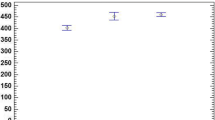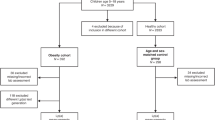Abstract
Elevated plasma homocysteine is widely seen as an independent risk factor of cardiovascular disease in adults. In order to investigate the role of homocysteine in a paediatric population at risk for early atheroclerosis, we studied plasma homocysteine in obese schoolchildren and non-obese peers. Plasma homocysteine, serum vitamin B12 and serum folic acid were determined in 41 obese and 27 control subjects and related to carotid intima-media thickness and flow-mediated dilatation measured on high-resolution ultrasonography. Homocysteine, vitamin B12 and folic acid were all significantly elevated in obese children. In girls, plasma homocysteine correlated significantly with body mass index (r=0.56, p=0.002), increased ICA intima-media thickness (r=0.39, p=0.035) and flow-mediated dilatation (r=−0.40, p=0.031). In boys, none of these associations reached significance (all p>0.234). No independent association of homocysteine with IMT and FMD was seen after adjustment for BMI. Conclusion: Plasma homocysteine is elevated in obese schoolchildren with hypertension and dyslipidaemia, particularly in girls. This may indicate a high-risk constellation, so that plasma homocysteine should be monitored in these children.
Similar content being viewed by others
Abbreviations
- ANCOVA:
-
Analysis of covariance
- BMI:
-
Body mass index
- CCA:
-
Common carotid artery
- (c)IMT:
-
(carotid) Intima-media thickness
- DBP:
-
Diastolic blood pressure
- FMD:
-
Flow-mediated dilatation
- ICA:
-
Internal carotid artery
- SBP:
-
Systolic blood pressure
References
Allen RH, Stabler SP, Savage DG, Lindenbaum J (1993) Metabolic abnormalities in cobalamin (vitamin-B12) and folate deficiency. FASEB J 7:1344–1353
ARIC Investigators (1997) Association of coronary heart disease incidence with carotid arterial wall thickness and major risk factors: the Atherosclerosis Risk in Communities (ARIC) Study, 1987– 1993. Am J Epidemiol 146:483–494
Bots ML, Hoes AW, Koudstaal PJ, Hofman A, Grobbee DE (1997) Common carotid intima- media thickness and risk of stroke and myocardial infarction: the Rotterdam Study. Circulation 96:1432–1437
Bots ML, Dijk JM, Oren A, Grobbee DE (2002) Carotid intima-media thickness, arterial stiffness and risk of cardiovascular disease: current evidence. J Hypertens 20:2317–2325
Brattstrom L, Wilcken DE (2000) Homocysteine and cardiovascular disease: cause or effect? Am J Clin Nutr 72:315–323
Clarke R, Armitage J (2000) Vitamin supplements and cardiovascular risk: review of the randomized trials of homocysteine-lowering vitamin supplements. Semin Thromb Hemost 26:341–348
De Bree A, Mennen LI, Bertrais S, Zuriek M, Blacher J, Potier de Courcy G (2003) Relation between homocysteine concentrations and structural and functional arterial parameters in a French general population. J Inherit Metab Dis 26 (Suppl 1):24
De Laet C, Wautrecht JC, Brasseur D, Dramaix M, Boeynaems JM, Decuyper J (1999) Plasma homocysteine concentration in a Belgian school-age population. Am J Clin Nutr 69:968–972
Delvin EE, Rozen R, Merouani A, Genest J Jr, Lambert M (2000) Influence of methylenetetrahydrofolate reductase genotype, age, vitamin B-12, and folate status on plasma homocysteine in children. Am J Clin Nutr 72:1469–1473
Durga J, Bots ML, Schouten EG, Grobbee DE, Kok FJ, Verhoef P (2003) Homocysteine not associated with intima-media thickness. J Inherit Metab Dis 26 (Suppl 1):25
Glowinska B, Urban M, Koput A, Galar M (2003) New atherosclerosis risk factors in obese, hypertensive and diabetic children and adolescents. Atherosclerosis 167:275–286
Graham IM, Daly LE, Refsum HM, Robinson K, Brattstrom LE, Ueland PM (1997) Plasma homocysteine as a risk factor for vascular disease: the European concerted action project. JAMA 277:1775–1781
Greenlund KJ, Srinivasan SR, Xu JH, Dalferes E, Myers L, Pickoff A (1999) Plasma homocysteine distribution and its association with parental history of coronary artery disease in black and white children: the bogalusa heart study. Circulation 99:2144–2149
Higginbottom MC, Sweetman L, Nyhan WL (1978) A syndrome of methylmalonic aciduria, homocystinuria, megaloblastic anemia and neurologic abnormalities in a vitamin B12-deficient breast-fed infant of a strict vegetarian. N Engl J Med 299:317–323
Homocysteine Lowering Trialists’ Collaboration (1998) Lowering blood homocysteine with folic acid based supplements: meta-analysis of randomised trials. BMJ 316:894–898
Lobo A, Naso A, Arheart K, Kruger WD, Abou-Ghazala T, Alsous F (1999) Reduction of homocysteine levels in coronary artery disease by low-dose folic acid combined with vitamins B6 and B12. Am J Cardiol 83:821–825
Louwman MW, van Dusseldorp M, van de Vijver FJ, Thomas CM, Schneede J, Ueland PM (2000). Signs of impaired cognitive function in adolescents with marginal cobalamin status. Am J Clin Nutr 72:762–769
Magyar MT, Szikszai Z, Balla B, Valikovics A, Kappelmayer J, Imre S, Balla G, Jeney V, Csiba L, Bereczki D (2003) Early-onset carotid atherosclerosis is associated with increased intima-media thickness and elevated serum levels of inflammatory markers. Stroke 34:58–63
Malinow MR, Nieto FJ, Szklo M, Chambless LE, Bond G (1993) Carotid artery intimal-medial wall thickening and plasma homocyst(e)ine in asymptomatic adults: the atherosclerosis risk in communities study. Circulation 87:1107–1113
Monsen AB, Refsum H, Markestad T, Ueland PM (2003) Cobalamin status and its biochemical markers methylmalonic acid and homocysteine in different age groups from 4 days to 19 years. Clinical Chemistry 49:2067–2075
Osganian SK, Stampfer MJ, Spiegelman D, Rimm E, Cutler JA, Feldman HA (1999) Distribution of and factors associated with serum homocysteine levels in children: child and adolescent trial for cardiovascular health. JAMA 281:1189–1196
Refsum H, Ueland PM, Nygard O, Vollset SE (1998) Homocysteine and cardiovascular disease. Annu Rev Med 49:31–62
Seshadri N, Robinson K (2000) Homocysteine, B vitamins, and coronary artery disease. Med Clin North Am 84:215–237
Sorof JM, Alexandrov AV, Cardwell G, Portman RJ (2003) Carotid artery intimal- medial thickness and left ventricular hypertrophy in children with elevated blood pressure. Pediatrics 111:61–66
The Homocysteine Studies Collaboration (2002) Homocysteine and risk of ischemic heart disease and stroke-a meta-analysis. JAMA 288:2015–2022
Tounian P, Aggoun Y, Dubern B, Varille V, Guy- Grand B, Sidi D (2001) Presence of increased stiffness of the common carotid artery and endothelial dysfunction in severely obese children: a prospective study. Lancet 358:1400–1404
Van Beynum IM, Smeitink JAM, den Heijer M, te Poele Pothoff MTWB, Blom HJ (1999) Hyperhomocysteinemia: a risk factor for ischemic stroke in children. Circulation 99:2070–2072
Wald DS, Law M, Morris JK (2002) Homocysteine and cardiovascular disease: evidence on causality from a meta-analysis. BMJ 325:1–7
WHO (2002). World Health Report for 2002: Reducing risks, promoting healthy life. Chapter 9: Noncommunicable diseases, including mental health. pages 124– 131. (available at http://www.who.int/archives/)
Woo KS, Chook P, Yu CW, Sung RY, Qiao M, Leung SS (2004) Overweight in children is associated with arterial endothelial dysfunction and intima-media thickening. Int J Obes Relat Metab Disord 28:852–857
Zhu WH, Huang XM, He J, Li MX, Neubauer H (2005) Arterial intima-media thickening and endothelial dysfunction in obese Chinese children. Eur J Pediatr 164:337–344
Zhu WH, Li MX, Huang XM, Neubauer H (2005) Association of hyperviscosity and subclinical atherosclerosis in obese schoolchildren. Eur J Pediatr 164:639–645
Author information
Authors and Affiliations
Corresponding author
Rights and permissions
About this article
Cite this article
Zhu, W., Huang, X., Li, M. et al. Elevated plasma homocysteine in obese schoolchildren with early atherosclerosis. Eur J Pediatr 165, 326–331 (2006). https://doi.org/10.1007/s00431-005-0033-8
Received:
Accepted:
Published:
Issue Date:
DOI: https://doi.org/10.1007/s00431-005-0033-8




